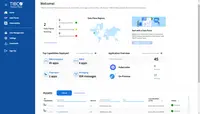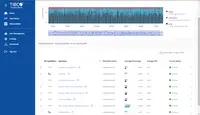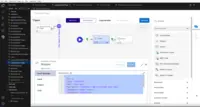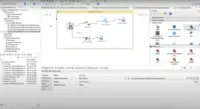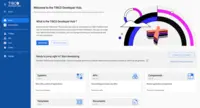TIBCO Integration (including BusinessWorks and Flogo)
Overview
What is TIBCO Integration (including BusinessWorks and Flogo)?
TIBCO Integration is used to connect diverse business solutions, data sources, and devices into a single, seamless system.
Broaden your horizon with Scribe
The Best integration tool in the world.
A good project accelerator
Could be better, does some of the jobs, but gets frustrating for API calls. Documentation is also too generic and they need recipes.
Stay tuned on data with TIBCO Businessworks!
TIBCO BUSINESSWORKS - More than just an Integration tool
Scribe Integration to Microsoft Dynamics GP
TIBCO Cloud Integration (including BusinessWorks and Scribe) at a glance!
Trust My Review
TIBCO Cloud Integration (including BusinessWorks and Scribe) is great!
TIBCO and Sales Order Process.
Empowering Seamless Integration with TIBCO Cloud Integration's Versatility and Performance
Seamless integration made easy
Reasons to use TCI
How TIBCO Integration (including BusinessWorks and Flogo) Differs From Its Competitors
TIBCO Platform Integration
Cloud Benefits
Cloud Migration
TIBCO Investment Preservation
Future Proofing
Customer Feedback
TIBCO Platform Integration
Business Impact
Deployment
Flexibility
Reliability and Strength
Decision Factors
Cloud Benefits
TIBCO Investment Preservation
Future Proofing
Customer Feedback
Requirements
Future Use
TIBCO Cloud Integration Learning from the Community
TIBCO Platform Integration
Tasks Accomplished
Cloud Benefits
TIBCO Platform Integration
Little early to comment on the impact of …
TIBCO Products Used
Tasks Accomplished
Business Impact
Deployment
Flexibility
Reliability and Strength
Decision Factors
TIBCO Platform Integration
TIBCO Platform Integration
TIBCO Cloud Integration Impact
Lessons for Success
Cloud Benefits
Cloud Migration
TIBCO Investment Preservation
Future Proofing
Customer Feedback
Another really annoying thing: The mappings …
Requirements
Considerations
Future Use
Decision Factors
Recommendations
Deployment
Integrations
Integration Special Use case
TIBCO Cloud Integration Learning from the Community
TIBCO Cloud Integration Tips and Tricks
TIBCO Cloud Integration Favorite Features
2. Multiple agents: My solutions can connect to different agents on different on-premise systems. This speeds up the integration a lot
3. Lots of connectors: These are really helpful with most of the common data sources
TIBCO Cloud Integration Features You Wish You'd Used Sooner
TIBCO Cloud Integration Feature Differentiators
Cloud Benefits
Cloud Migration
TIBCO Investment Preservation
Future Proofing
Customer Feedback
TIBCO Cloud Integration Favorite Features
- Deploy directly from Business Studio with few click
- Out of the box integration to expose private endpoints only with Tibco Mashery
- Scaling directly from the UI
TIBCO Cloud Integration Features You Wish You'd Used Sooner
TIBCO Cloud Integration Feature Differentiators
There is still some limitation but Messaging provide out of the box many solutions. In Cloud world is a point to consider.
TIBCO Cloud Integration Impact
Lessons for Success
Lessons for Success
TIBCO Cloud Integration Impact
Lessons for Success
TIBCO Cloud Integration Impact
Lessons for Success
Requirements
Considerations
It is difficult to indicate other IPaaS solutions since there is not much competition in this type of services, since many organizations have seen the need to mount an IaaS solution to be able to install integration products. It is also important that TIBCO CI not only offers APIs layer but also …
Future Use
From my point of view, this growth model is very oriented to internet-scale business models, and here is a strength of TIBCO CI given that being an IPaaS solution it allows to have elasticity strategies, and step by use that allow these prepared for unexpected consumption peaks, also the speed of …
Decision Factors
To choose TIBCO Cloud Integration, there are several criteria where this platform provides added value, such as the agility of generation of integration and interoperability solutions, the adequate management of autonomy provided by the architecture to support the workloads. In the case of …
Recommendations
For this type of decision, the advantage that TIBCO CI has is that it appears in Gartner, the second scenario is the strength of the manufacturer in this case TIBCO in solutions of this type. In the technical aspects, the ease of generating solutions must be taken into account and being able to …
Integration Special Use case
TIBCO Cloud Integration Onboarding Wisdom
TIBCO Cloud Integration Learning from the Community
TIBCO Cloud Integration Tips and Tricks
TIBCO Cloud Integration Favorite Features
- The different connectors ready to configure and …
TIBCO Cloud Integration Features You Wish You'd Used Sooner
TIBCO Cloud Integration Feature Differentiators
TIBCO Cloud Integration Impact
Integration Special Use case
TIBCO Cloud Integration Onboarding Wisdom
TIBCO Cloud Integration Learning from the Community
TIBCO Cloud Integration Tips and Tricks
Create a job to actually delete the target records marked as 'Deleted'.
TIBCO Cloud Integration Favorite Features
TIBCO Cloud Integration Features You Wish You'd Used Sooner
TIBCO Cloud Integration Impact
The map customization is fairly …
Lessons for Success
TIBCO Cloud Integration has allowed us to successfully and smoothly integrate data between multiple disparate systems.
The most important lesson I've learned is to keep things simple. While the integration process is very easy to follow, it's important to keep configurations simple because you may …
Decision Factors
Recommendations
Deployment
Integrations
Integration Special Use case
TIBCO Cloud Integration Onboarding Wisdom
TIBCO Cloud Integration Learning from the Community
TIBCO Cloud Integration Tips and Tricks
TIBCO Cloud Integration Impact
The revisions functionality has also made rolling back really good.
Decision Factors
Needs to be competitive for our customers when going up against other products.
Deployment
Integration Special Use case
TIBCO Cloud Integration Onboarding Wisdom
Know your scenarios, know your systems data structure and you will pick it up
TIBCO Cloud Integration Learning from the Community
TIBCO Cloud Integration Feature Differentiators
And its reliability
Decision Factors
Prices were negotiated, since we were loyal tibco customers.
Also TIBCO Cloud simplifies the way data are captured, applications connect, and turn …
Deployment
- A highly available architecture
- A VPC configured with public and private subnets according to AWS best practices
- An Internet Gateway to allow access to the WEB
- In public subnets, NAT Gateways managed to authorize outgoing …
Integrations
- AWS CloudWatch Logs
- AWS ECR Repository
- AWS S3 bucket
TIBCO Cloud Integration Favorite Features
2- The Drag and Drop feature that easily allow developer to create flow, parse messages, and perform complex mapping.
3- The software is very user friendly.
TIBCO Cloud Integration Features You Wish You'd Used Sooner
TIBCO Cloud Integration Feature Differentiators
TIBCO Cloud Integration Favorite Features
TIBCO Cloud Integration Features You Wish You'd Used Sooner
TIBCO Cloud Integration Feature Differentiators
TIBCO Cloud Integration Impact
TIBCO Cloud Integration Impact
TIBCO Cloud Integration Impact
Lessons for Success
Integration Special Use case
TIBCO Cloud Integration Onboarding Wisdom
TIBCO Cloud Integration Learning from the Community
TIBCO Cloud Integration Tips and Tricks
TIBCO Cloud Integration Favorite Features
TIBCO Cloud Integration Features You Wish You'd Used Sooner
TIBCO Cloud Integration Feature Differentiators
TIBCO Cloud Integration Impact
Lessons for Success
TIBCO Cloud Integration Favorite Features
1. Easy of use - the tool is easy to use and can be taught (at a basic level) to most end users; not requiring a huge understanding of computer programming.
2. Logging - the tool has vast logging mechanism built in; though the alert …
TIBCO Cloud Integration Features You Wish You'd Used Sooner
TIBCO Cloud Integration Feature Differentiators
TIBCO Cloud Integration Impact
TIBCO Cloud Integration Impact
TIBCO Cloud Integration Impact
TIBCO Cloud Integration sample maps
Awards
Products that are considered exceptional by their customers based on a variety of criteria win TrustRadius awards. Learn more about the types of TrustRadius awards to make the best purchase decision. More about TrustRadius Awards
Popular Features
- Pre-built connectors (120)7.575%
- Support for real-time and batch integration (117)7.070%
- Monitoring console (120)6.969%
- Connector modification (8)5.555%
Reviewer Pros & Cons
Pricing
What is TIBCO Integration (including BusinessWorks and Flogo)?
TIBCO Integration is used to connect diverse business solutions, data sources, and devices into a single, seamless system.
Entry-level set up fee?
- Setup fee optional
Offerings
- Free Trial
- Free/Freemium Version
- Premium Consulting/Integration Services
Would you like us to let the vendor know that you want pricing?
Alternatives Pricing
What is Azure Logic Apps?
Microsoft offers the Azure Logic Apps as a cloud-based integration service, supporting data and application integration.
What is SAP Integration Suite?
SAP Integration Suite is an integration platform-as-a-service (iPaaS) that helps quickly integrate on-premises and cloud-based processes, services, applications, events, and data. It is used to accelerate innovation, automate more processes, and realize a faster time to value.
Features
Cloud Data Integration
Cloud data integration software simplifies the task of integrating data from multiple different cloud applications
- 7.5Pre-built connectors(120) Ratings
Pre-built, tested connectors to a wide variety of applications such as ERP, CRM, HCM, Marketing Automation, etc.
- 5.5Connector modification(8) Ratings
Provision for modification of pre-built connectors to suit specific environments
- 7Support for real-time and batch integration(117) Ratings
Software supports both real-time and batch integrations
- 5.5Data quality services(6) Ratings
Software includes capability to perform data profiling, deduplication, cleansing etc.
- 2.7Data security features(7) Ratings
Data security features include rights management, LDAP integration, password encryption, etc.
- 6.9Monitoring console(120) Ratings
Central console for monitoring resource utilization, system health, ability to start and stop processes, etc.
Product Details
- About
- Integrations
- Competitors
- Tech Details
- Downloadables
- FAQs
What is TIBCO Integration (including BusinessWorks and Flogo)?
TIBCO Integration is used to connect diverse business solutions, data sources, and devices into a single, seamless system. TIBCO accelerates connectivity initiatives with low and no-code experiences engineered to reduce development time and costs. Users can implement the best-fit style of integration to address any app, data, IoT, B2B and mobile/web integration use case. TIBCO Integration can connect to virtually any endpoint across the IT ecosystem with 200+ pre-built connectors for a wide variety of business suites, databases and legacy technologies.
TIBCO Integration (including BusinessWorks and Flogo) Features
Cloud Data Integration Features
- Supported: Pre-built connectors
- Supported: Support for real-time and batch integration
- Supported: Monitoring console
Additional Features
- Supported: No-code Business Process Automation
- Supported: No-code Graphical Designer
- Supported: Container and PaaS Support
- Supported: Enterprise Scale
TIBCO Integration (including BusinessWorks and Flogo) Screenshots
TIBCO Integration (including BusinessWorks and Flogo) Integrations
- Salesforce Sales Cloud
- HubSpot Marketing Hub
- Microsoft SQL Server
- Adobe Marketo Engage
- Microsoft Dynamics GP
- SAP ERP, ECC
- MySQL
- NetSuite ERP
- PostgreSQL
- Salesforce Marketing Cloud
- ServiceNow IT Service Management
- Shopify
- Google Analytics
- Jira Software
- Sage Intacct
- ON24
- Oracle Marketing
- Oracle Database (legacy)
- Sugar Sell (SugarCRM)
- Microsoft Dynamics 365 Business Central
- Microsoft Dynamics 365
- Microsoft Dynamics AX, discontinued
- Adobe Commerce (Magento Commerce)
TIBCO Integration (including BusinessWorks and Flogo) Competitors
TIBCO Integration (including BusinessWorks and Flogo) Technical Details
| Deployment Types | On-premise, Software as a Service (SaaS), Cloud, or Web-Based |
|---|---|
| Operating Systems | Windows, Linux, Mac |
| Mobile Application | No |
| Supported Countries | Global |
| Supported Languages | English |
TIBCO Integration (including BusinessWorks and Flogo) Downloadables
Frequently Asked Questions
Comparisons
Compare with
Reviews and Ratings
(502)Attribute Ratings
- 1Likelihood to Renew28 ratings
- 8.9Availability6 ratings
- 7.2Performance6 ratings
- 4.5Usability23 ratings
- 7.3Support Rating28 ratings
- 5.6Online Training3 ratings
- 1.3In-Person Training5 ratings
- 10Implementation Rating8 ratings
- 7.3Configurability5 ratings
- 7.8Product Scalability23 ratings
- 7.3Ease of integration21 ratings
- 7.3Vendor pre-sale4 ratings
- 7.3Vendor post-sale6 ratings
Reviews
(1-25 of 112)TIBCO user
- It is immediate thanks to the graphical interface
- Very useful for creating web services
- You can integrate many systems between them
- It can integrate cloud systems
- It should be more stable
- It should also be an open source version
- It should incorporate test data management, such as queues or database
- Add more plugins
The Best integration tool in the world.
- We found Scribe tool is consistent for successfully processing data without any issues.
- Good ability to reconnecting the systems when ever their is any issue with source/target systems.
- I found Connecting to various systems is complex in Scribe when compared to BusinessWorks.
- Hard to view any successful data which Scribe processed, as it does not store and when the target system have any issues so at this time its hard to know what data Scribe has processed.
A good project accelerator
- Integration with external systems
- Error management
- Technical orchestration
- Adding new connectors
- Integration with other TIBCO tools
Could be better, does some of the jobs, but gets frustrating for API calls. Documentation is also too generic and they need recipes.
- data replication
- data sync
- API calls
- JSON Normalization
Stay tuned on data with TIBCO Businessworks!
- Access to real-time data across different environments.
- No need to know a specific language code.
- Expose multiple business processes as web methods under one service.
- Manage JDBC.
- Global Variables.
- SOAP over HTTP.
Scribe Integration to Microsoft Dynamics GP
- Offer integration for various modules of GP.
- Groups and alerts are easy to set-up.
- Initial configuration and installation are lengthy.
- Does not roll back all errors.
- Automation of development pipelines
- Use of microservices for Agile SDLC
- Automation of business process and workflows
- Still figuring out debugging
- Integration with other TIBCO tools can be a tedious task
TIBCO and Sales Order Process.
- The UI is easy to navigate and map flows are intuitive and easy to build upon after some basic training. However, a user should have some basic knowledge of writing nested statements.
- Very responsive customer support.
- The debug feature is a great tool for troubleshooting. You can easily identify where the issue is in your flow. At each debug step, it returns the expected value, and when there isn't the expected value, you know when to modify your flow.
- It seems to struggle with being able to query large data sets. It would error out when attempting to query about 15K customer accounts.
- Training. I had to look on the internet for some videos to understand how the control boxes work. When we initially installed TIBCO we received a crash course. You need someone with a good analytical, technical, or data background to use this tool.
- Error messages doesn't always match the issue causing the error.
Empowering Seamless Integration with TIBCO Cloud Integration's Versatility and Performance
- Real Time billing updates
- Network status update
- CRM data synchronisation
- managing easily complex data mapping and transformation among different systems
- it requires specific skill to use it
- licence management is complex with many options
Less Appropriate Scenarios:
- when use case are with Limited Budget and Resources
- in case of highly specialised integration between specific systems
Reasons to use TCI
- Security policies for authorization and authentication
- Error handling made easy
- Plugins to connect with systems
- Logging - providing a inbuilt log framework
- Feature to easily generate yaml files
Less appropriate if there are complex transitions and business logics to be implemented
Great for Dynamics CRM
- Easy integration, even for non-programmers
- It can connect to a lot of different systems/databases easily
- The support is helpful and questions are answered fast and professionally. And if nothing helps, you get remote live-support
- Good on-site training available
- It is fast and (the CRM module) has the ability to cache query results
- Export and import of mappings are very easy
- Easy change of connections in (imported) mappings
- The debugger is a pain. Sometimes it is hard to find an issue
- It is not possible to split the integrations into steps. You need to copy/paste (and maintain) integration-steps that are used in multiple integrations
- You cannot call a flow from another flow
BW Man
Main scenario: Integrate internal source systems based on different technologies with SAP C4C CRM. An event based architecture was built using an In-Only pattern based on XML over JMS. Soap over http services exposed by SAP were easily consumed using the out of the box functionality of the product.
The integration layer was built defining a Canonical Data Model to reduce the number of transformations and simplify the code maintenance.
- Easy web service development (REST & SOAP)
- Easy mapping transformations : XML/JSON, XPATH
- Management of run-time entities
- Simple deployment
- Many adapters available
- One IDE for 3 different runtimes (On Premises, Container, Cloud)
- Improve Business Studio stability
1) Event based architectures based on XML over JMS
2) Synchronus services implementation based on SOA with SOAP
3) REST stateless rest services
4)Implementation of transformations patterns
5)Microservices development
- Connector towards Hubspot and MS CRM works good for Scribe.
- Incremental updates based off last run date.
- Building blocks in Scribe work fine.
- Annoying lockout of webapp during development.
- Error handling is not so informative.
- Help and support info is not the best.
- Functions, lookups and more technical features are not as good as SSIS.
Review
- Integration with internal systems.
- Integration with external systems.
- Rest API development.
- TIBCO support can be provided in a better way.
- Handling JSON transformation.
- Heavy weight.
- Robustness
- Simplicity for designing solutions
- Ability to connect to multiple sources
- Easy to debug
- Easy to use drag and drop in Designer
- Integration with native self-built Java modules is difficult
- Can be less heavy on memory use
- Difficult for users with no IT experience
TIBCO BusinessWorks Review by Leonardo Cruz Mesa
- It is a product that allows distributed solutions that complies with SOA principles
- With the principle of non-code, it helps companies have more agility and better understand their processes and fulfill the business objectives.
- Manage real-time information for new business decision-making strategies
- There are few customers with the product in my country Colombia. So the potential of the platform is not known.
- Not much documentation for independent developers.
Scribe Replication Service Issues
- Daily Replication succeeds without errors more often than not.
- The Replication Service does not include the ability to "pre-filter" the data in any way, i.e., it gets ALL records from the beginning of time and ALL columns, many of which are not used in CRM.
- Several errors with records that fail to be processed are frequently reported, including "Execution timeout expired", "data would be truncated", and "Cannot insert duplicate key row". I've opened support cases for these, but none seem to have a solution I can use.
- The row counts of all entities replicated should be approximately equal to the row counts in the source database, but several entities' counts are significantly different.
- In the Scribe Online web app pages, the error details panel cannot be resized andruns off the bottom of the screen, making impossible to read the entire error message.
Scribe - Easy to Use, Functional and Fantastic
We use Scribe to transfer data between multiple systems. From our account/contract system to our CRM system, as well as from our CRM system to another database.
Scribe plays a major role in making sure we have data integrity across multiple systems. It allows to avoid manual updates of data between system, which is crucial when we have limited staff. This allows staff to focus on other job duties.
- The creation of integration maps is straightforward.
- The ability to schedule when solutions are run is of great value because we need to have systems updated in a particular order. Scheduling makes this easy.
- When errors do occur, the error messages give enough information to allow us to diagnose how we need to fix records as necessary.
- The system could be a little faster when navigating within maps. Sometimes there are delays while the page loads.
- There could be more examples of how to use Scribe in the documentation.
- I would suggest that Scribe provide suggestions when sending error messages eg Have you tried to refresh the metadata? This would save contacting support for some people.
Off the top of my head, I don't have any scenarios where it is less appropriate because if you want to move data between two systems, Scribe is one of the best options.
Scribe Online: Use it
- Point and click design for integration maps
- Simple scheduling of integrations
- Useful error reporting
- Since moving to Scribe online: no publisher
- Online editor can be sluggish: lagging
- Debug should mimic a commit not actually commit
- Improve having live and testing integrations in one tenancy
TIBCO BW : The rolls royce of integration solutions
- Quick developement
- Quick deployment
- Easy monitoring
- Easy scaling
- API Rest and JSON tools are not natively available in the designer V5
- Sometimes the mapping tab presents some bugs (for example : if statement)
- Maven cannot be used to build TIBCO BusinessWorks projects
TIBCO Cloud Integration Review
- Easy to use
- Clean interface
- Good customer service
- Lots of errors--having to restart the system and losing work in the process
- Solutions are cumbersome and very difficult to organize.
- System periodically will just not work, specifically when you are trying to fetch records to preview.
- System is VERY slow.
Solutions are extremely difficult to organize because everything is in one spot and is paged. This is probably my biggest issue with the system, besides the frequent seemingly random errors.
Live fast with BusinessWorks
It is used by a department for manufacturing electronic system. It keeps separate logic from implementation, making it easy for application to call services. Logging and centralization let us easily detect problems.
We use TIBCO Rendezvous protocol behind BusinessWorks
For example, we use a service to retrieve data between different systems and though different protocols (FTP, shell script...) making all transparent to clients.
- Abstraction of logic
- Robustness (very high)
- Good maintainance
- Versatility
- Usability of GUI (too many settings in too many places)
- Slow management interface
- Difficult to learn
Appropriate when you need to highly monitor the service you do, or when you do not have rights or code for some parts of the service.
Good for big applications and for selling your service to customers, not to use for small web applications, the effort is not worth it. Now there are plenty of cheaper alternatives.
TIBCO BusinessWorks, Integrate the incompatible
TIBCO BW is used across the whole organization. It is an efficient software to ease the integration process of backend and front-end systems. It supports a wide variety of technology like SAP,Siebel,PeopleSoft,Facebook etc etc. Someone using TIBCO BW does not have to worry about data conversion issues between front-end and back-end systems or incompatible software products. It seamlessly converts the data via the use of XML as a standard.
It is a highly scalable and reliable software that has many supporting technologies like JDBC, JMS, different databases, messaging systems, data conversion system. It is extremely user friendly using the Eclipse UI as a standard and is highly customizable.
It is certainly a leader in the integration software industry.
- Data conversion
- Data transfer
- Integration
- Can be less heavy on memory use
- Should be accessible for students for further enhancement
- Can be expanded for use with more open source products
A lot of potential, but it's got a long way to go
- Scribe has a lot of connectors for different types of sources and targets
- Security is easy to maintain in Scribe
- Scribe's use of graphical mapping designer makes it easy to visualize what a map is doing
- List view filtering is annoying in the interface. It does not save your filter or page that you were viewing. So if you click on a solution and then return to the list, the view is reset. You also cannot filter on solution status.
- Often the metadata for sources and targets do not display in mappings. Sometimes you have to close and reopen a map several times before the fields will display. It's extremely slow.
- There is no way to stop run-away processes via the application. I've had many instances where a process has been hung and cannot be stopped without calling in a ticket. Usually, it perpetually stay s in that state and you end up needing to recreate the solution.
- There is no way to purge the internal database file used on the Scribe agent. Once it reaches a maximum size (which is small), the agent becomes unusable and needs to be retired.
- It's difficult to manage which solutions are using which agents and which solutions are using which connections. There should be easier ways to report on this information.
- Often your changes appear to have been saved but are actually not saved and the solution does not run correctly.
- I've had instances where a source Oracle view is inputting x number of records but Scribe does not process them and does not produce any sort of error. It just looks as if there was nothing to process. This happens randomly.
- The "statistics" produced by the solutions do not make it easy to understand which maps produced which update/create counts. Also, the record counts are difficult to interpret and also thrown off by batching. Other cloud services seem to be able to produce easy to read record counts by step even when they include batching. Not sure why this cannot.
- There is no good instruction for determining the correct number of maps per solution or number of agents per server that are recommended.
- There is no facility for running pre and post processing commands (like in other similiar apps). So you cannot have a script to check for presence of a file or to delete a file or create a trigger file.
- Flat file handling is not very powerful and is clunky. If you want to change the delimiter used by a source or target file, you need to manually recreate the entire definition. You can import from a sample file, but the individual field type and sizes are lost.
- If you want to reassign a connection for a solution (like UAT to PROD), you need to go into each individual map and change the source there instead of being able to do it at the solution level.
- There is no way to copy a solution. You can have to export all the maps individually, create a new solution and then import all those maps. Then go into each one and wait for the metadata to refresh and then save each one (sometime several times) in order for it to become "complete".
- The progress counter is very slow to update on running solutions
- When a solution is running, there is no way to tell which map is currently executing within the solution.
- If you run an individual step within a solution instead of the entire solution, there is no way to tell which step is running until it's done.
- Validation within a map is cloogy. the slowness of the interface causes lag in the map validation. this flags errors that no longer exist.
- Mapping fields could be easier. there is no marker on the source side to show which fields have been mapped and which haven't. This is a pain when you have hundreds of fields to map. Other similar apps show a check mark.
- There are so many little things that could be improved about the user interface. I could go on and on.
Because of the diverse connector types available, Scribe is useful for accessing a variety of source/target types.
Tibco BW is relatively a very good product for implementing the Enterprise/Corporate level backend data processing
- The main strength of Tibco BusinessWorks is the seamless integration of development/testing/deployment.
- The learning curve of Tibco BusinessWorks Designer is not so steep, which helps to achieve a quick to the market strategy.
- The many levels configuration overriding possibility makes the solution flexible.
- The RESTful + JSON support is still not too perfect.
- The integration with the native self-developed Java modules is still lacking general framework support.
- It's too flexible to override the configuration properties on domain/engine/process/server levels and sometimes causes project management and maintenance problems.


